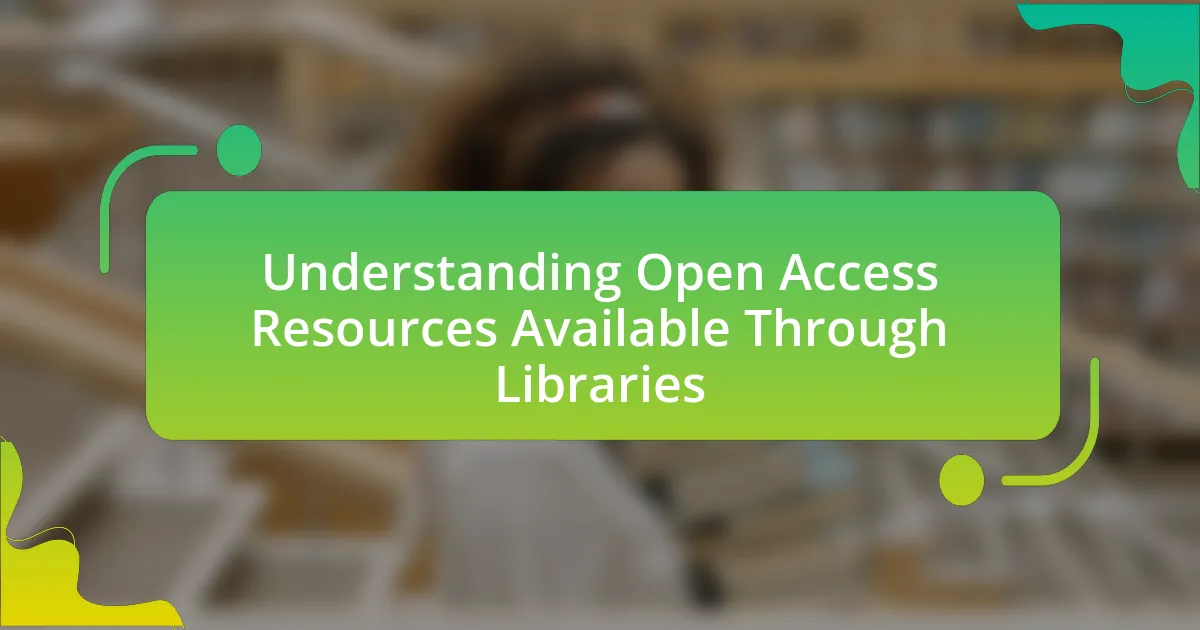Interlibrary Loan Services are essential systems that enable libraries to borrow and lend materials on behalf of their patrons, significantly enhancing access to resources not available in local collections. This article outlines the functioning of these services, including the steps involved in requesting materials, the types of resources that can be accessed, and the importance of interlibrary loans for comprehensive research. It also discusses the benefits for researchers, common challenges faced, and best practices for maximizing the use of these services. Additionally, the role of library staff and available resources to assist users are highlighted, providing a thorough understanding of how interlibrary loans facilitate academic collaboration and improve research outcomes.

What are Interlibrary Loan Services?
Interlibrary Loan Services are systems that allow libraries to borrow and lend materials to each other on behalf of their patrons. This service enables users to access books, articles, and other resources that are not available in their home library’s collection. According to the American Library Association, interlibrary loans facilitate resource sharing among libraries, enhancing the availability of information and supporting comprehensive research efforts.
How do Interlibrary Loan Services function?
Interlibrary Loan Services function by allowing libraries to borrow materials from one another on behalf of their patrons. When a library does not have a specific book, article, or other resource, it can request that item from another library that holds it. This process typically involves the requesting library submitting a loan request through a centralized system or directly contacting the lending library. The lending library then decides whether to fulfill the request based on its policies and availability. Once approved, the item is sent to the requesting library, where it can be accessed by the patron. According to the American Library Association, interlibrary loan services significantly expand access to resources, enabling users to obtain materials that may not be available in their local library collections.
What steps are involved in requesting materials through Interlibrary Loan Services?
To request materials through Interlibrary Loan Services, follow these steps: First, identify the item you need, ensuring it is not available in your library’s collection. Next, access your library’s Interlibrary Loan system, which may be an online portal or a physical form. Fill out the request form with accurate details about the item, including title, author, publication date, and any other relevant information. Submit the request, and then monitor your email or library account for updates regarding the status of your request. Once the item is available, you will receive instructions on how to retrieve it. These steps are standard across many libraries, ensuring a streamlined process for obtaining materials not held in your local collection.
What types of materials can be requested through Interlibrary Loan Services?
Interlibrary Loan Services allow users to request a variety of materials, including books, journal articles, theses, and other academic resources. These services facilitate access to items not available in the user’s home library, thereby expanding research capabilities. For instance, many libraries participate in networks that enable the sharing of resources, ensuring that users can obtain specific titles or articles needed for their studies.
Why are Interlibrary Loan Services important for research?
Interlibrary Loan Services are important for research because they provide access to a vast array of resources that may not be available within a single library’s collection. This service enables researchers to obtain books, articles, and other materials from libraries across the country or even internationally, thereby expanding the scope of their research. For instance, a study published in the Journal of Academic Librarianship found that 70% of researchers reported that interlibrary loans significantly enhanced their ability to access necessary information for their work. This access is crucial for comprehensive literature reviews, supporting evidence-based research, and fostering collaboration among scholars.
How do Interlibrary Loan Services enhance access to resources?
Interlibrary Loan Services enhance access to resources by allowing libraries to borrow materials from one another, thereby expanding the range of available information for patrons. This service enables users to obtain books, articles, and other resources that may not be present in their home library’s collection. According to the American Library Association, interlibrary loans significantly increase the accessibility of scholarly materials, with millions of items exchanged annually among libraries, thus facilitating comprehensive research opportunities for users.
What role do Interlibrary Loan Services play in academic collaboration?
Interlibrary Loan Services facilitate academic collaboration by enabling institutions to share resources, thereby expanding access to a wider range of materials. This service allows libraries to borrow books, articles, and other resources from one another, which is essential for researchers who may not have access to specific texts within their own library collections. For instance, a study by the Association of Research Libraries found that interlibrary loans significantly enhance research capabilities by providing access to over 90 million items across participating libraries. This collaborative effort not only fosters a culture of sharing knowledge but also supports the advancement of research by ensuring that scholars can obtain necessary resources regardless of their institutional limitations.

What are the benefits of utilizing Interlibrary Loan Services?
Utilizing Interlibrary Loan Services provides access to a vast array of resources not available in a single library’s collection. This service allows patrons to borrow books, articles, and other materials from participating libraries, significantly expanding research capabilities. According to the American Library Association, interlibrary loans can enhance the availability of scholarly resources, enabling users to obtain specific texts that support their academic or personal inquiries. This collaborative network among libraries ensures that users can access a broader spectrum of information, thereby enriching their research experience.
How can Interlibrary Loan Services improve research outcomes?
Interlibrary Loan Services can significantly improve research outcomes by providing access to a wider range of resources that may not be available in a researcher’s home library. This expanded access allows researchers to obtain books, articles, and other materials that are crucial for their studies, thereby enhancing the depth and breadth of their research. For instance, a study by the American Library Association found that 90% of academic libraries participate in interlibrary loan programs, facilitating the sharing of over 10 million items annually. This collaboration among libraries ensures that researchers can access diverse perspectives and data, ultimately leading to more comprehensive and informed research findings.
What specific advantages do researchers gain from using Interlibrary Loan Services?
Researchers gain access to a broader range of resources through Interlibrary Loan Services, which allows them to obtain materials not available in their home institution’s library. This service enhances research capabilities by providing access to specialized books, journals, and articles that may be crucial for comprehensive studies. For instance, a study published in the Journal of Academic Librarianship found that 70% of researchers reported improved research outcomes due to access to materials via interlibrary loans, demonstrating the service’s significant impact on academic work.
How do Interlibrary Loan Services support diverse research needs?
Interlibrary Loan Services support diverse research needs by providing access to a wide range of materials that may not be available in a user’s home library. These services enable researchers to obtain books, articles, and other resources from various libraries, thus expanding their access to specialized information and unique collections. For instance, a study by the American Library Association indicates that interlibrary loans can significantly enhance research capabilities by allowing users to tap into the holdings of multiple institutions, thereby facilitating comprehensive literature reviews and in-depth studies across various disciplines.
What challenges might users face when using Interlibrary Loan Services?
Users may face several challenges when using Interlibrary Loan Services, including delays in receiving materials, limited availability of requested items, and potential fees associated with borrowing. Delays can occur due to processing times at lending libraries, which may take several days to weeks, impacting research timelines. Additionally, not all libraries participate in interlibrary loans, leading to limited access to specific titles or resources. Furthermore, some libraries impose fees for borrowing items, which can deter users from utilizing the service. These challenges can hinder the efficiency and effectiveness of comprehensive research efforts.
What common issues arise during the Interlibrary Loan process?
Common issues that arise during the Interlibrary Loan (ILL) process include delays in receiving materials, miscommunication between libraries, and restrictions on loanable items. Delays often occur due to processing times at lending libraries or shipping logistics, which can extend the wait for requested items. Miscommunication can lead to requests being misunderstood or incorrectly fulfilled, resulting in patrons receiving the wrong materials. Additionally, some libraries impose restrictions on certain types of materials, such as reference books or newly published items, limiting the availability of resources for users. These issues can hinder the efficiency and effectiveness of utilizing ILL services for comprehensive research.
How can users effectively troubleshoot problems with Interlibrary Loan Services?
Users can effectively troubleshoot problems with Interlibrary Loan Services by first verifying their library account status and ensuring that all necessary fees are paid. This step is crucial because an inactive account can prevent access to services. Next, users should check the specific loan policies of their library, as different institutions may have varying rules regarding borrowing limits and eligible materials. Additionally, users can contact their library’s Interlibrary Loan department directly for assistance, as staff can provide guidance on specific issues such as delays or unfulfilled requests. According to the American Library Association, clear communication with library staff can significantly enhance the troubleshooting process, ensuring that users receive timely and accurate support.

How can researchers maximize their use of Interlibrary Loan Services?
Researchers can maximize their use of Interlibrary Loan Services by clearly identifying their information needs and utilizing library resources effectively. By specifying the exact titles, authors, and publication dates of the materials they require, researchers can streamline the request process, reducing the time needed to obtain resources. Additionally, maintaining regular communication with library staff can enhance understanding of the services available and any potential limitations. According to the American Library Association, effective use of Interlibrary Loan can significantly expand access to materials not held in a researcher’s home library, thereby supporting comprehensive research efforts.
What best practices should researchers follow when utilizing Interlibrary Loan Services?
Researchers should follow several best practices when utilizing Interlibrary Loan Services to enhance their research efficiency. First, they should clearly identify and specify the materials needed, including titles, authors, and publication dates, to facilitate accurate requests. Second, researchers must be aware of their institution’s policies regarding Interlibrary Loans, including any fees, borrowing limits, and turnaround times, which can vary significantly between libraries. Third, maintaining open communication with library staff is crucial; they can provide guidance on the best ways to submit requests and may offer alternatives if the desired materials are unavailable. Additionally, researchers should plan ahead, allowing sufficient time for materials to arrive, especially for critical deadlines. Lastly, keeping track of borrowed items and adhering to return deadlines is essential to avoid penalties and ensure continued access to library services. These practices are supported by library science literature, which emphasizes the importance of clear communication and planning in optimizing Interlibrary Loan experiences.
How can researchers effectively communicate their needs to library staff?
Researchers can effectively communicate their needs to library staff by clearly articulating their specific information requirements and deadlines. This involves providing detailed descriptions of the materials needed, such as titles, authors, publication dates, and any relevant context that can assist library staff in fulfilling the request. For instance, a study by the Association of College and Research Libraries emphasizes the importance of precise communication in enhancing the efficiency of interlibrary loan services, indicating that well-defined requests lead to quicker and more accurate responses from library personnel.
What strategies can enhance the efficiency of the Interlibrary Loan process?
Implementing automated systems and streamlined communication can significantly enhance the efficiency of the Interlibrary Loan (ILL) process. Automation reduces manual errors and speeds up the request and fulfillment stages, while effective communication between libraries ensures that requests are processed quickly and accurately. For instance, libraries that utilize integrated library systems (ILS) can automate the tracking of requests and manage workflows more efficiently, leading to faster turnaround times. Additionally, establishing clear protocols and guidelines for ILL staff can minimize delays and improve service consistency, as evidenced by studies showing that libraries with standardized procedures report higher user satisfaction and reduced processing times.
What resources are available to assist users of Interlibrary Loan Services?
Interlibrary Loan Services provide various resources to assist users, including online catalogs, user guides, and dedicated staff support. Online catalogs allow users to search for materials available through interlibrary loans, while user guides offer step-by-step instructions on how to request items. Additionally, library staff are available to answer questions and provide assistance throughout the loan process, ensuring users can effectively utilize these services for their research needs.
How can library guides and online resources support Interlibrary Loan users?
Library guides and online resources support Interlibrary Loan users by providing essential information on how to effectively utilize these services. These resources typically include step-by-step instructions for requesting materials, tips for identifying eligible items, and guidance on navigating the interlibrary loan system. For instance, many libraries offer online tutorials and FAQs that clarify the process, which can enhance user understanding and efficiency. Additionally, library guides often feature links to databases and catalogs that help users locate materials available for loan, thereby streamlining the research process.
What role do library staff play in facilitating Interlibrary Loan Services?
Library staff play a crucial role in facilitating Interlibrary Loan Services by managing requests, coordinating with other libraries, and ensuring the efficient delivery of materials. They assess the needs of patrons, process loan requests, and communicate with partner libraries to secure the necessary resources. According to the American Library Association, effective interlibrary loan services enhance access to a broader range of materials, thereby supporting comprehensive research efforts.
What tips can help researchers navigate Interlibrary Loan Services successfully?
To navigate Interlibrary Loan Services successfully, researchers should first familiarize themselves with their institution’s specific policies and procedures regarding interlibrary loans. Understanding the types of materials available, such as books, articles, and media, is crucial, as well as knowing the estimated timeframes for receiving requested items. Researchers should also ensure they provide complete and accurate citation information when making requests, as this increases the likelihood of successful fulfillment. Additionally, utilizing online catalogs and databases effectively can streamline the search process for needed materials. According to the American Library Association, proper use of interlibrary loan services can significantly enhance access to resources, thereby supporting comprehensive research efforts.






